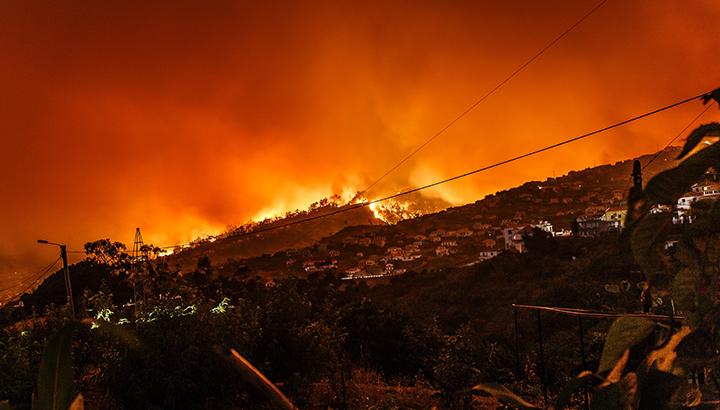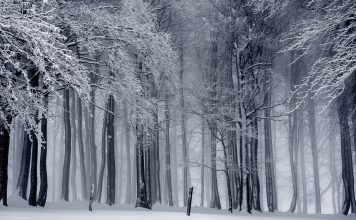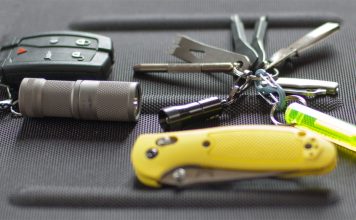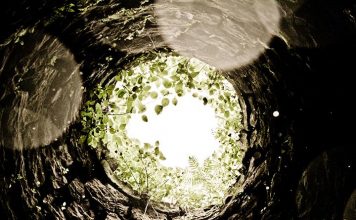|
||
| Issue #104 • March/April, 2007 |
Over the last few decades there has been a growing interest in nature. Not that there wasn’t an interest before, but there is a trend to build homes nestled in the midst of nature, to bask in the peace and soothing presence. Unfortunately, we are seeing this development create new problems requiring innovative solutions.
My profession is that of a structural firefighter. Most people assume a firefighter is a firefighter; that is, they are all interchangeable. Well, they are to a point. I am a structural firefighter with training in fire suppression in houses, industrial settings, cars, trains, and boats. Wildland firefighters have very different training. Their training focuses more on brush fires, cutting fire lines, falling trees, and weather conditions.
Structural firefighters don’t cut fire breaks. Wildland firefighters don’t enter burning structures. Yet, there is a place where these two worlds collideat that beautiful house surrounded on three sides by old-growth forest.
Every year throughout the nation wildland fires threaten homes. The number is increasing as more homes are built in natural settings. When I first became a firefighter, we never received calls for assistance from our wildland counterparts. Now, it is commonplace. Each year, our region sends units to homes threatened by wildfires. Keep in mind that these are not structural firefighters asked to fight wildland fires, but to prevent wildland fires from destroying homes. It is nothing but a defensive action, and wildland firefighters do not have the training, manpower, or equipment to tackle the problem alone.
|
As a structural firefighter with experience in these “Urban Interface” fires, I’d like to share some of the secrets of creating a survivable home in the path of a wildfire. I have had to take drastic measures with homes in an attempt to save them, such as eliminating the landscaping or cutting off a deck. However, with a little forethought and planning, these drastic measures can easily be avoided.
When structural firefighters are called to a wildland fire, they are often assigned the task of preparing a house for the ensuing arrival of a fire. One could easily think that they would lay a supply line from the nearest fire hydrant, stretch hose, and prepare to flow 2,000 gallons a minute to hold back a wall of fire. Unfortunately, it doesn’t quite work that way. Depending on the fire, one fire engine may be responsible for three or even a dozen homes. It’s also possible that they may not be allowed to utilize water from a hydrant system, as that could endanger lives that are depending on the water pressure further up the line. The reality of it is that structural firefighters will “triage” the buildings they are responsible for. If they can all be saved, great. If allocating time and resources for one home could endanger three others, it’s possible the first one will be written off. It’s a tough call, but all too often necessary.
When a structural crew arrives at an urban interface setting, they have a lot of work to do: Clear brush, move woodpiles, protect LPG tanks, remove shrubbery, wet roofs or yards, and yes, even remove decks from the sides of buildingsand sometimes only have 20 minutes per house. They will make a judgment call of what they can save with the allotted time, manpower, and equipment. The more defensible and prepared your house is, the more likely the firefighters will devote resources to it simply because it’s a battle they can win.
So what can be done? Should you surround yourself with a non-combustible 20 foot high wall? No. How about a medieval moat? Probably not. Many things that can be done are chores you are already doing.
Below is a brief list of some items worth considering. Not all of them will apply to your circumstances, but give thought to each:
When building a home
Strongly consider non-combustible roofing materials. Although cedar shake roofs look great, they are, well…kindling. If homeowner association rules require shake roofs, consider the non-combustible shake roof substitutes that are available on the market. You can check out MonierLifetile.com for examples. If you must get cedar, get treated cedar with fire retardant.
Use noncombustible siding. I’ve seen vinyl siding melt and flow down the sidewalk as it was burning. Use protective shutters for your windows, or perhaps noncombustible drapes.
Install multiple water outlets around the exterior of your home. If you are installing new piping, the bigger the better. Half-inch pipe is only capable of flowing a dozen or so gallons each minute. A 1 inch pipe can flow 4 times that amount. During initial construction, these are important details, and any small investment at this time reaps huge dividends when you need it most.
Consider the exposure that decks, carports, and other structures have when fire has an opportunity to get below. If possible, brick in or at least frame in below decks. If fire gets below a structure, it is extremely hard to defend. Stop it from getting there. This is the reason so many decks are removed from a house.
Landscaping
Keep trees away from the house the same distance they are high. An 80-foot tree should be 80 feet away from your buildings. Plant fire-resistant shrubs and trees such as ferns and hardwoods. Generally, deciduous trees are better than conifer. Plant grass around your house. Green grass, properly trimmed, is a great fire deterrent. Consider an automatic sprinkler system for the yard. The ability to remotely water your surroundings could be helpful.
Firewise.org has a great listing of trees and shrubs that are fire resistant. It is listed state by state and is an excellent resource.
Planning for future events
Thin the number of trees immediately adjacent to your home. Trees should have a 15 to 20 foot gap between them within a 100 foot radius of your home. Remove “ladder fuels”branches and shrubs that could take a ground fire into the tops of trees. A ground fire that extends into the crown of trees has grown exponentially worse. Typically, removing ladder fuels would entail cutting the limbs and branches from trees up to 15 feet.
|
Place cement or gravel pads under LPG tanks. Typically (but not always), propane tanks are installed away from the house. Eliminating fuels underneath will improve the survivability of the tank and possibly your house. Of course, don’t forget to shut off gas if a wildland fire is approaching.
If your house is surrounded by low brush, lay a “fire break” around your house about 100 feet away and 3 to 6 feet in width; it could also be used as a walking or jogging path. This should be gravel, concrete, or at least bare earth. The higher the fuels, the wider the fire break needs to be.
Install a water supply that would be available for fire suppression. This could be a “dry hydrant” to a swimming pool, a pond, or creek. Admittedly, this could be a big task, but having an independent water supply is a fantastic resource for fire suppression efforts. Remember, fire engines are often prohibited from utilizing fire hydrants. They rely on tenders (water-carrying emergency vehicles) for their water supply. They are in great demand, and they don’t get around to the engines very often. Help yourself out and give the fire engine its own water supply. Again, if the resources are there, the chances are better that the firefighters will make a stand at your residence. Contact your local fire department about a dry hydrant system. Ensure the connections on your dry hydrant are what your department uses.
General fire safety precautions
Make sure your home’s address is visible from the street. It is a simple thing, but you’d be amazed at how many don’t have a good address posted. Some fire departments will provide you with an address sign free of charge. Check your smoke detectors regularly (and make sure you have enough; they are cheap enough to have one on each floor and one in each bedroom). Have fire extinguishers available in the garage and kitchen, and make sure all members of the family know how to use them. Store woodpiles 100 feet away from the house, and downhill. Having your burning woodpile roll against your home is not a pleasant thought. Have a ¼ inch screen installed on your woodstove chimney; you don’t want to be responsible for starting a wildland fire.
Before the fire season
Clean your gutters; your home doesn’t need the extra fuel. Remove tree limbs from above your house. Rake up leaves, twigs, and other combustibles around your buildings. Keep vegetation off of the house. Have a good ladder to reach your roof, along with shovels, axes, rakes, and plenty of garden hose.
Make plans as to where you would evacuate, and what routes you would use (make sure you have a map). If your house is on a slope, take steps to address problems uphill that could roll downhill.
During a wildland fire incident
Wear quality boots, gloves, pants, long-sleeve shirt, and eye protection, if needed. If you need to protect your breathing, you probably shouldn’t be there.
• Position your vehicle facing the road for a rapid escape.
• Make sure swimming pools or portable tanks are full.
• Reevaluate the trees on your property. Better to lose a few trees than your trees plus your house.
• Close curtains and move combustibles either into the house or 100 feet away.
• Shut off your LPG tank or natural gas.
Extraordinary protective measures
Occasionally, firefighters consider a house lost and don’t expend any effort to save it. This could be because of its isolation, lack of resources, or inability to get equipment where it needs to be. There are still steps you can take. Consider purchasing a portable water tank, especially if you do not have another independent source of water. Purchase a portable firefighting pump with hose and nozzles.
|
Class “A” foam or “gel” could be an option. Although it’s expensive, it can provide a barrier that attaches to the side of your home. But be careful. Salesmen will tell of the long duration of foam, but the minute foam is applied, it begins to deteriorate. If you are not careful, you could be left with an expensive soap puddle that will not assist your home’s defense at all. As technology improves, foams are getting better, but it’s not the cure-all that some would lead you to believe.
Speaking of firefighting equipment, I have had great success with local fire department surplus equipment sales. I have nozzles, hose, tools, and other equipment. I also am aware of a private, isolated community that purchased their own fire truck for a couple of thousand dollars. My own fire department has surplused working fire engines with 500-gallon tanks for as little as $2,000. Ebay is another good source for surplus firefighting equipment; just be sure of what you are purchasing. Don’t buy equipment blindly. Determine what you need and stick with it.
Build a wider, substantial fire break. That’s one of your best (and cheapest) defenses. Consider using a disk behind your tractor to improve the width. But remember, a fire break isn’t just on the ground level. Take the time to look up into the trees. You might need to make a difficult decision about which trees need to go. If in doubt, cut it down.
Install sprinklers on the roof, particularly if your roof is of combustible construction. Sprinklers on your roof will not save your house if the fire burns closeby. It will, however, suppress the flying embers that emit from the fire front. It could be that embers are the only attack your house will face. Be prepared for it.
Keep the surrounding landscaping green and hydrated. Water is fire’s enemy. More water in the plants will keep the fire from burning as hot. If it’s not as hot, there’s less radiant heat attacking your home.
In conclusion, look at your house objectively. Stop looking at the stack of wood next to the house as a convenient place to put the wood to save a long walk. Look at it as a fire doesit’s a stepping stone from the forest to your home. A fire break, or jogging path might look like work to maintain, but it’s also a powerful barrier to ground fires. Appropriate construction and landscape modifications make a tremendous difference should your house be confronted with a wildland fire. That lesson has been learned too late by many unfortunate homeowners. It is my hope that you can take a few of these points and use them to your advantage. Or you can bury your head in the sand and hope firefighters will do it for you. Somehow, I think the readers of this magazine will see fit to be a tad more proactive.


















I am going to send this to my sister in Montana. A number of years ago, they were burned out, down to the ground with a ground fire that moved too fast for her to get much out of the house. None of what you have written about did they have in place. The moved back to the land and have a few out buildings and a marginal pole barn built but another fire will sweep across them in a minute because they have none of this in place. Thank you , this is an excellent article for anyone!